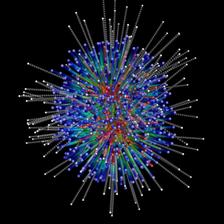The researchers found that since proteins exposed to X-ray laser pulses explode in predictable and reproducible patterns, they could use these patterns to reconstruct the complexities of the folded protein. (Credit: Carl Caleman, CFEL/Uni Uppsala)
A team led by Carl Caleman, a scientist at the Center for Free Electron Science at DESY, has developed a method of elucidating protein structures when they are similar. The technique uses the remnants of protein molecules exploded by X-ray laser pulses produced by facilities such as FLASH and the European XFEL. If one such exploded protein structure is known, then a second similar one will leave a respectively similar signature that can be used to infer details of the protein structure. The results are published as an "Editors' Suggestion" in the journal Physical Review Letters.
Protein structures are complex and multi-layered, a puzzle that has been attracting scientists’ interest for decades. These structures are essential to understanding biology, with major effects in medicine, pharmacology, environmental science, bioengineering, and many other fields. In 2024, protein folding, the most complicated of the layers of protein structure, won the Nobel Prize in Chemistry. The project awarded the prize used machine learning to identify structures from the most basic level of complexity, the sequence of amino acids, and calculating up to the folding level. The results of this study can help complement the output of the Nobel-winning program by studying protein molecules that are exploded like a firework using an X-ray laser.
When hit by intense X-ray pulses like those produced by FLASH or the European XFEL, most molecules, including proteins, dissociate into their constituent atoms. The team led by Caleman – based at Uppsala University in Sweden, where he is also a professor – noted that the atoms scattered in a consistent manner – including when the proteins are blown up that look very similar to one another. “We’d seen that lysozyme (a very common enzyme) had sulfur atoms moved in the same direction,” Caleman says. The team discovered in their simulations that the protein explosions were reproducible. Caleman, who works in the Coherent Imaging Division at CFEL at DESY, compares the blown-up proteins to an exploded car. “If you were to blow a car up, you’d see where the wheels went afterwards, where the roof went,” he says. “You can trace all those parts back to the location of the explosion and get a decent idea of what the car looked like in the first place. We do the same thing with the proteins, where we can see how the different parts of the protein scatter away from the explosion. In the end, it’s very simple: blow it up and look at where the fragments landed.”
Using a simulation package and two different algorithms for analysing the scatter of the atoms in the explosions, the team compared these to proteins that did not look similar using the same procedure. The results showed that the similarity only occurred when the proteins actually did have almost the same folding pattern. “For example, we had two proteins that had a stretched versus compact folding pattern – they were quite easy to separate just by looking at their remnants as an ion map,” Caleman says. “But on two proteins from the capsid of a virus that look similar, but where one is symmetrical and the other has a slight asymmetry in its structure, the patterns they left also looked similar.” The team needed more sophisticated standard statistical techniques to identify the proteins based on the remnants of the two explosions, but they could be individually classified. Repeated attempts yielded the same results. “That was very exciting,” Caleman says. The simulation also takes into account information from a similar experiment published in 2022 that took place at European XFEL, where a smaller, simpler molecule was exploded and so identified.
AlphaFold, the project that won the 2024 Nobel Prize, is extremely powerful in its predictive abilities, but there are occasions when the results of this analysis can give multiple possible outcomes. The findings from Caleman and his group give a possible way of refining such results. AlphaFold has trouble predicting certain folds, partly because its main knowledge base comes from experiments using crystallised proteins. The procedure used in this study uses proteins that are uncrystallised and can help elucidate uncertainties about particular molecules’ folds.
The next steps for the team are to perform their simulation in an experiment at an X-ray laser. To do this, they have teamed with experts in sample delivery who can help make ultrarefined samples so that the conditions in the simulation and the experiment are as similar as possible. This will involve use of the MS SPIDOC system developed by an international EU-funded consortium around Charlotte Uetrecht, a University of Lübeck professor of biochemistry and scientist at the Centre for Structural Systems Biology at DESY. “If this develops further, we could open up a whole new way of getting structures of proteins,” Caleman says. “As long as the explosion is reproducible, this should work.”
(from DESY News)
Reference:
T André, I Dawod, S Cardoch et al., Protein Structure Classification Based on X-Ray-Laser-Induced Coulomb Explosion, Physical Review Letters (2025), DOI: https://doi.org/10.1103/PhysRevLett.134.128403







